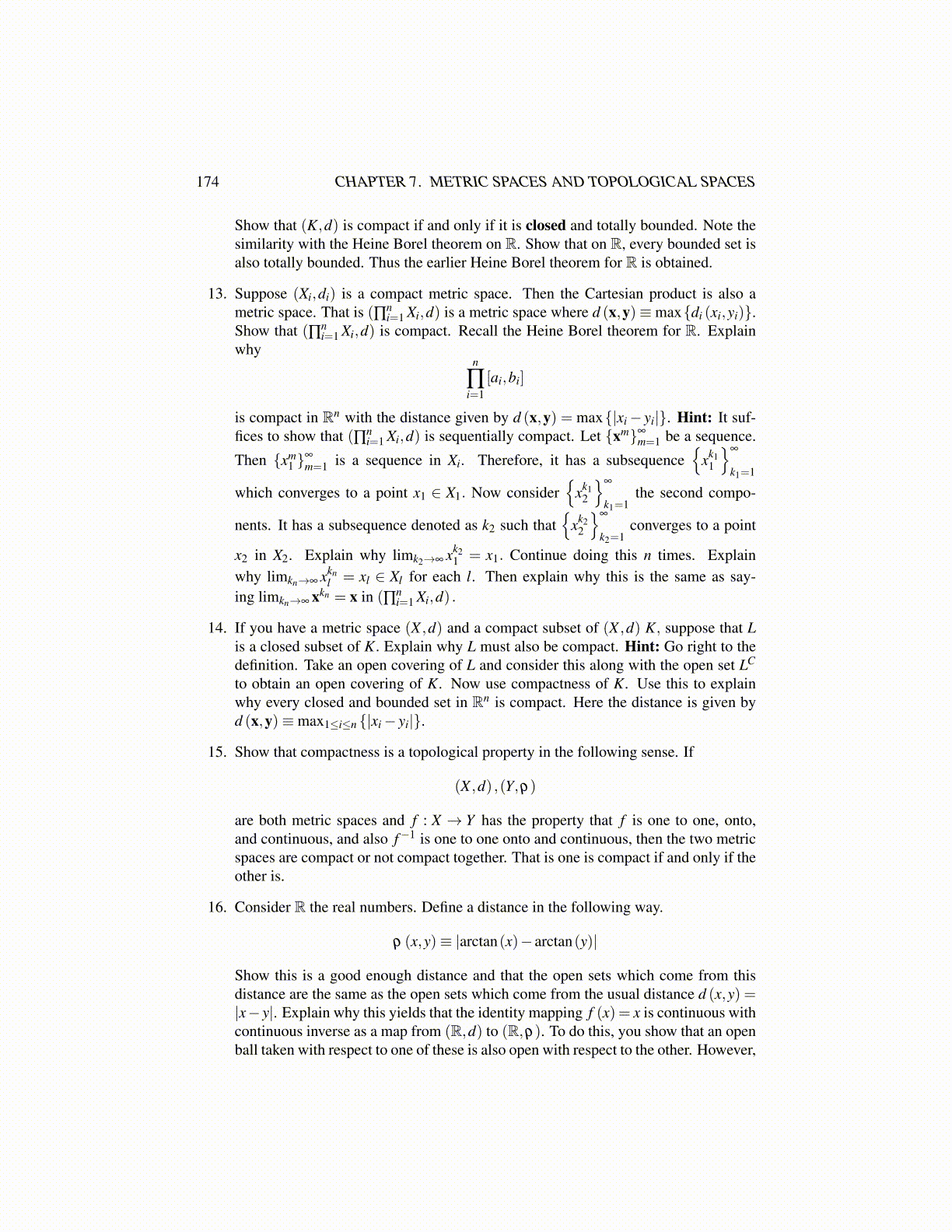
174 CHAPTER 7. METRIC SPACES AND TOPOLOGICAL SPACES
Show that (K,d) is compact if and only if it is closed and totally bounded. Note thesimilarity with the Heine Borel theorem on R. Show that on R, every bounded set isalso totally bounded. Thus the earlier Heine Borel theorem for R is obtained.
13. Suppose (Xi,di) is a compact metric space. Then the Cartesian product is also ametric space. That is (∏n
i=1 Xi,d) is a metric space where d (x,y)≡max{di (xi,yi)}.Show that (∏n
i=1 Xi,d) is compact. Recall the Heine Borel theorem for R. Explainwhy
n
∏i=1
[ai,bi]
is compact in Rn with the distance given by d (x,y) = max{|xi− yi|}. Hint: It suf-fices to show that (∏n
i=1 Xi,d) is sequentially compact. Let {xm}∞
m=1 be a sequence.
Then {xm1 }
∞
m=1 is a sequence in Xi. Therefore, it has a subsequence{
xk11
}∞
k1=1
which converges to a point x1 ∈ X1. Now consider{
xk12
}∞
k1=1the second compo-
nents. It has a subsequence denoted as k2 such that{
xk22
}∞
k2=1converges to a point
x2 in X2. Explain why limk2→∞ xk21 = x1. Continue doing this n times. Explain
why limkn→∞ xknl = xl ∈ Xl for each l. Then explain why this is the same as say-
ing limkn→∞ xkn = x in (∏ni=1 Xi,d) .
14. If you have a metric space (X ,d) and a compact subset of (X ,d) K, suppose that Lis a closed subset of K. Explain why L must also be compact. Hint: Go right to thedefinition. Take an open covering of L and consider this along with the open set LC
to obtain an open covering of K. Now use compactness of K. Use this to explainwhy every closed and bounded set in Rn is compact. Here the distance is given byd (x,y)≡max1≤i≤n {|xi− yi|}.
15. Show that compactness is a topological property in the following sense. If
(X ,d) ,(Y,ρ)
are both metric spaces and f : X → Y has the property that f is one to one, onto,and continuous, and also f−1 is one to one onto and continuous, then the two metricspaces are compact or not compact together. That is one is compact if and only if theother is.
16. Consider R the real numbers. Define a distance in the following way.
ρ (x,y)≡ |arctan(x)− arctan(y)|
Show this is a good enough distance and that the open sets which come from thisdistance are the same as the open sets which come from the usual distance d (x,y) =|x− y|. Explain why this yields that the identity mapping f (x) = x is continuous withcontinuous inverse as a map from (R,d) to (R,ρ). To do this, you show that an openball taken with respect to one of these is also open with respect to the other. However,